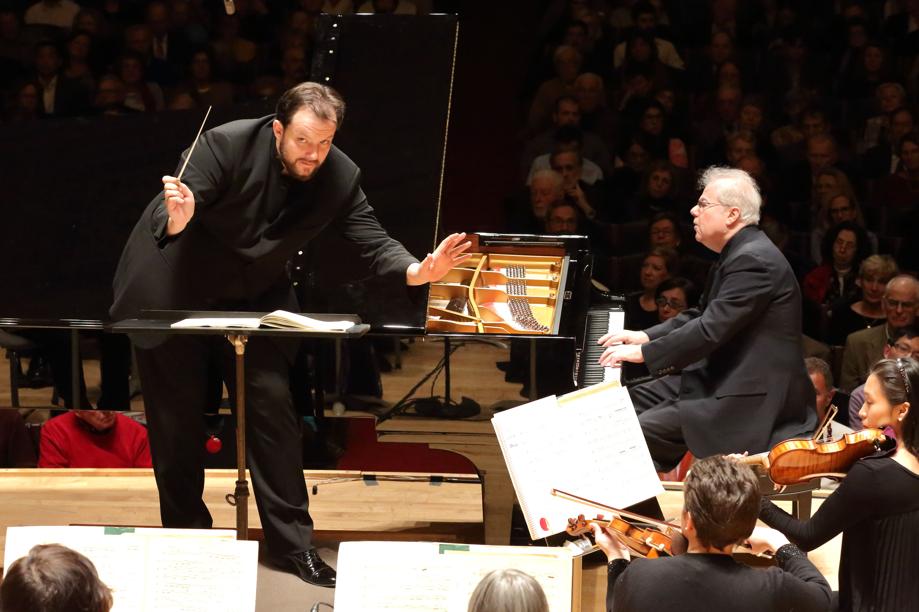
music review
BOSTON SYMPHONY ORCHESTRA
At Symphony Hall Feb. 14 and 16. (second program repeats Feb. 18, 21). 888-266-1200, www.bso.org
Beethoven perpetually looms over the stage of Symphony Hall, his name emblazoned on a golden plaque at the center of the proscenium arch. When the hall was built, it was intended that other composers’ names would shine from additional plaques, but the only one whose worthiness the directors could agree on was Beethoven. The gilded letters transform his name into something more myth than man, a venerated legend the heights of which no one can hope to scale.
On Tuesday night, world-renowned pianist and perennial Boston Symphony Orchestra guest star Emanuel Ax performed Beethoven’s Piano Concerto No. 2 with the orchestra led by music director Andris Nelsons, inhabiting the music with the wisdom and comfort that comes with years of experience. Playing from memory, he dialed up the intensity in the martial first movement’s cadenza from a gentle sparkle to a dazzling gleam, attacking the keys with percussive vigor. Ax’s confident pianissimos in the twilight-hued Adagio astounded in their serene power. Conductor and soloist took breathing room between figures as the movement wound down, a keen flute solo floating overhead. That deep peace launched into a strongly accented Rondo, with Ax unfurling zippy runs, easy trills, and mischievous grace notes.
The music crackled with collective vitality: of this earth, not of myth. When Nelsons and Ax re-entered the stage for a third ovation, they did so arm in arm, and on the fourth ovation, Ax conceded to the audience’s demand for an encore with a Chopin waltz.
Ax’s turn with the orchestra on Thursday night was not as spotless. In Mozart’s dulcet Piano Concerto No. 22, which ended the first half, Ax’s playing was no less self-possessed than on Tuesday, and his elegant cadenzas displayed his light-fingered virtuosity. However, the piece as a whole lacked a unified direction, even with a smaller orchestra. In the first and second movements, rubato was laid on a touch thick, bogging down the rhythms. The jaunty Rondo was more locked in.
The first piece on the program was Gunther Schuller’s “Seven Studies on Themes of Paul Klee,’’ an excellent example of the noted composer/pedagogue’s “third stream’’ utopian synthesis of classical and jazz. In the first movement, “Antique Harmonies,’’ Nelsons adeptly controlled the huge orchestra’s dynamics through clear cells of color, conveying its sizable mass without having to turn up the volume. “Arabian Town’’ featured oboist Keisuke Wakao leading a Middle Eastern-inflected tune above shimmering strings, and bassist Edwin Barker showed off his walking chops in the blues-noir “Little Blue Devil.’’ There was nothing else “The Twittering Machine’’ could have been called; its whimsical wind chirps were both charming and infinitely more pleasant to listen to than certain other “twittering’’ entities I shall not name.
Beethoven’s Symphony No. 3, “Eroica,’’ rounded out Thursday’s concert. Its iconic beginning chords rang out, two shots fired across the bow. The “Allegro con brio’’ of the first movement dragged when Nelsons emphasized transitions between sections by pulling back the speed and couldn’t push the energy level back up to where it had been. Brio, however, was in no short supply — in the slices of bold chords, in the way leadership of the melody passed between instruments, in the horn solo that got cut off by the full force of the ensemble’s recapitulation. The tragic funeral march and explosive scherzo were inverse in tempo but equal in potency. Nelsons brought a trickster spirit to the theme-and-variations finale, exaggerating pauses and urging on the violins while stomping his foot at the side of the podium.
Seeing that lofty plaque looking down on all somehow suggests that hearing Beethoven’s music at Symphony Hall should be an elevated experience. However, composers of the past do not live on through their names engraved in gold letters high above a stage. They live on down below, with us, through the hands of those who keep their music alive and through the hearts of those that love it.
BOSTON SYMPHONY ORCHESTRA
At Symphony Hall Feb. 14 and 16. (second program repeats Feb. 18, 21). 888-266-1200, www.bso.org
Zoë Madonna can be reached at zoe.madonna@globe.com. Follow her on Twitter @knitandlisten. Madonna’s work is supported by the Rubin Institute for Music Criticism, San Francisco Conservatory of Music, and Ann and Gordon Getty Foundation.



